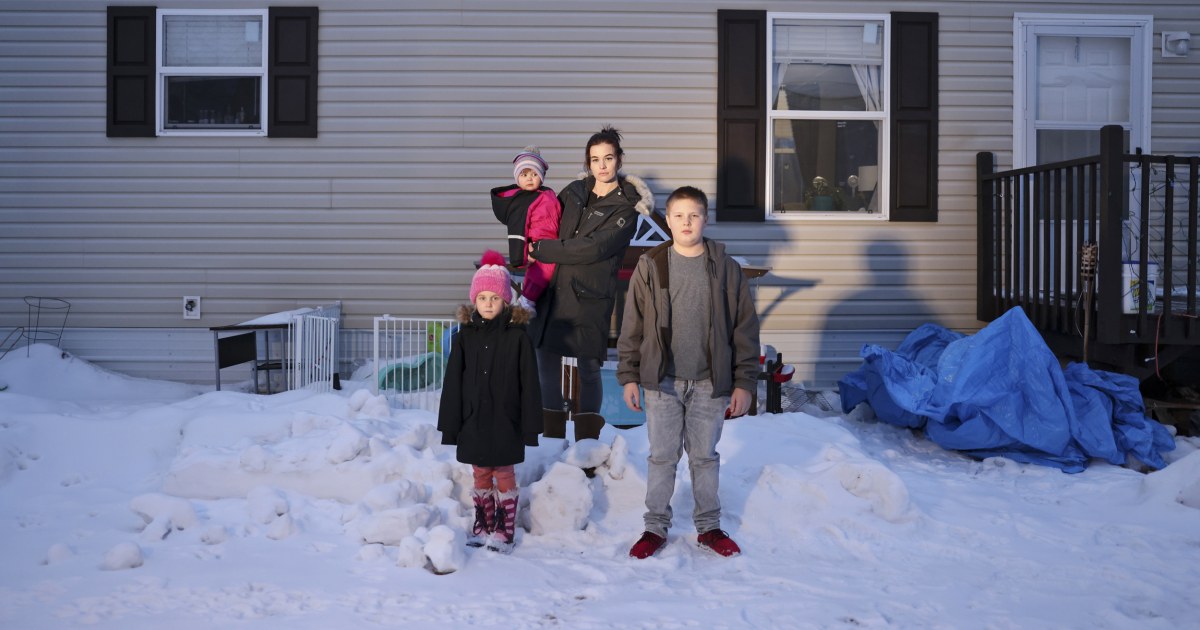
Chris Larson was preparing lasagna for Christmas Eve dinner last year when someone knocked on the door of the mobile home he owns with his fiancée, Kirsten Brokaw, and three kids in Superior, Wisconsin. An apologetic man dressed in jeans and a jacket stood at the door, handed him a stack of papers and said he was being evicted. He said the family had to leave by Jan. 20.
“We were using up all the money we had to pay down our lot rent,” Larson said. “We tried to keep up the best we could until then.”
Like hundreds of thousands of other people nationwide, Larson and his soon-to-be wife fell behind on rent last year as the coronavirus ripped across the country. The family’s financial troubles began when Brokaw suffered a stroke in March, leaving her unable to work. A couple of months later, Larson lost his job as a truck driver. By December, the family had fallen four months behind on rent and owed more than $4,700 in overdue lot payments, taxes and late fees to the mobile home park’s owner, called Homecroft Mobile Home Park, according to court documents reviewed by NBC News.
“I’m going to lose my home over a few months of lot rent,” Brokaw said. “I feel like we’re losing it all and all the hard work we did that got us to this point.”
Homecroft Mobile Home Park, which is listed on the website FostoriaReserve.com as one of its three communities in Ohio and Wisconsin, declined to comment on the case.
Affordable housing advocates have celebrated the Biden administration’s extension of the Centers for Disease Control and Prevention’s moratorium on evictions as a critical move that could help people fight to stay in their homes as the pandemic continues to gut the economy. But the order includes loopholes that financially stretched landlords have been able to use to remove tenants who fall behind on rent. Housing advocates say one of the hardest-hit groups has been mobile home park dwellers like Brokaw and Larson, who were already surviving with a limited safety net to fall back on. Before the pandemic, many mobile home residents, like Brokaw and Larson, had juggled paying for their mobile homes and for the lots they sat on. When they find themselves facing eviction, they risk losing not only the lot but also their home equity.
“In many cases, the tenant has 30 days to leave the lot. But how do you expect someone to pay a tow company $5,000 to $10,000 to detach their home from the property and reinstall it somewhere else?” said Stuart Campbell, a staff lawyer at Legal Aid of NorthWest Texas, who has been working on a steady stream of mobile home eviction cases through the pandemic. “Oftentimes when they are evicted for lot rent, they’re forfeiting the equity on the home. You could lose your home for $1.”
Starter homes
Before the pandemic, manufactured homes, the modern term for mobile homes, had become increasingly popular housing options for families with limited means who were looking for the amenities of the suburbs on small budgets, Campbell said. For an average of less than $1,000 a month in most parts of the country, a family can live in a 1,400-square-foot, pet-friendly home with a driveway, a yard and, maybe, a community swimming pool or a park, according to the Manufactured Housing Institute, an industry trade organization. With long backlogs for affordable housing, many families struggling financially have found manufactured homes to be compelling alternatives.
“You get more bang for your buck,” Campbell said.
There are 8.5 million manufactured homes in the U.S., nearly 10 percent of the country’s housing stock, according to the Manufactured Housing Institute. The median household income of a family living in a manufactured housing park is $30,000 a year, according to the institute.
“There are many determinants on where you live — I want to be close to family, I want to be close to my job,” said Kevin Borden, executive director of MHAction, a nonprofit that advocates for manufactured housing tenants. “And there also all those non-aspirational determinants — suppressed wages, lack of access to credit for women and women of color. Manufactured home communities really are this unique affordable landing spot no matter what fuels your decision.”
Finding space
The Superior home marked a new beginning for Larson and Brokaw. The couple had been living in a three-bedroom apartment with their children in Carlton, Minnesota. But Brokaw was determined to find a bigger home for the family. She worked 100 to 120 hours a week as a home health aide until she was 38 weeks pregnant with her youngest daughter to save money.
When Brokaw and Larson found the Fostoria Reserve Homecroft Mobile Home Park, they were hopeful. They moved into a four-bedroom, two-bath home in a safe and convenient neighborhood in a solid school district. The lot payment was about $525 a month, and the park offered financing to buy the $52,000 home through 21st Mortgage at $525 a month.
But what seemed like a stable financial path to own their home quickly unraveled in the pandemic-stricken economy. If they are evicted, they will have little recourse to recover the roughly $12,000 they have already invested in paying for their home.
Source: | This article originally belongs to Nbcnews.com









